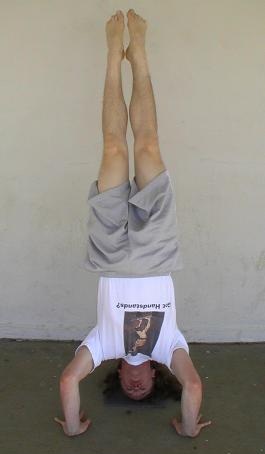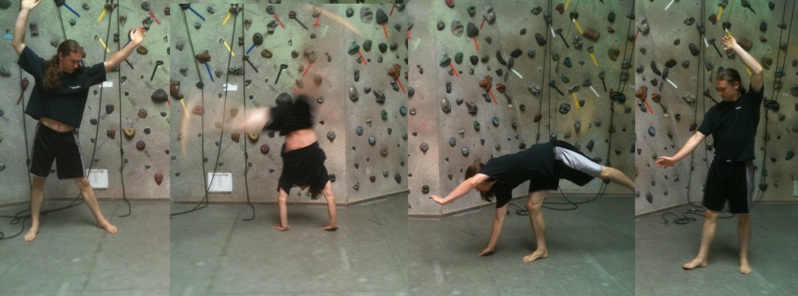Not everyone wants to be an acrobat or a gymnast. That’s fine, but there are some basic moves that I think every person who wants to be healthy and fit should be able to do.
To not be capable of these moves is like someone not being capable of running. They’re basic movement patterns that aren’t difficult, yet give you balance, coordination and mobility.
There are more moves than what we’ll cover here, but these 3 are great to start with.
The Somersault
Rolling is a skill that few people have, yet at times it could even save your life. It requires the coordination to control your body, and the flexbility to get into and move through a number of positions. Of course, it is also a starter skill, with many more advanced acrobatic skills that can be built on top of it.
It is advisable to do this on padded ground, like a mat, carpet or grass.
Start in a squat near the ground. Place your hands down about shoulder width apart. Tuck your head so that your chin is to your neck, tipping forward so that the top of your head touches the ground. Carry your momentum forward so you begin to roll. Keep your back as rounded as possible. Use the momentum as you turn over to come back to your feet.
Once you can do it easily from a squat, try it from standing, walking and even running.
The Headstand
The headstand is a static movement that requires balance and the body coordination to keep your body as one unit. I use this skill as a lead-up stunt to learning the handstand as it is far easier to do. With a tiny bit of practice anyone can be capable of holding this position.
this skill as a lead-up stunt to learning the handstand as it is far easier to do. With a tiny bit of practice anyone can be capable of holding this position.
If you’ve never tried it out before I recommend doing it against a wall, or with the help of a spotter in case you tumble over. Though once you’re practiced you can put the somersault we just covered to good use and roll out of the headstand.
Start in a squat. Place your hands about shoulder width apart with the finger facing forwards. Place your head down in front of the hands so that it forms a triangle. Either the top of your head, or the forehead where it meets the hairline is touching the floor. This position, like a tripod, makes balance much easier then if you were to place your hands and head in one line.
From here, tuck your legs in close to your body, then raise them until they are straight overhead, legs together and toes pointed.
Press in or let up with your hands to keep yourself balanced in space. With some practice holding this position for a minute is easy to do.
The Cartwheel
This move is harder then the other two, but still a simple movement itself. The cartwheel involves travelling through a handstand position as you go from one side to the other.
You’ll find one leg that is better than the other to start with, but with practice you’ll be able to do both sides almost equally well.
Start with your hands overhead. It is helpful to have them locked out. For this example let’s assume you’re pointing your right foot forward.
Your right foot points forward as you step with a bit of a lunge. The right hand will touch the ground with the hand pointed to your right. At this point the left leg will kick hard off the ground carrying your momentum up and forward. The left hand then comes to the ground parallel with the right about shoulder width apart. Now the right leg will kick off the ground continuing to spin you around. When you land your left leg will hit first and the foot will be pointing back towards the direction you came.
When done correctly, your hands and feet should all be in one striaght line where they touched the ground. Also you should become completely vertical, through a handstand position as you do the cartwheel. If you don’t come vertical you can still do a semi-cartwheel but it will not flow the same nor look as good.
To give you more momentum try running or walking into the cartwheel. These are tougher to do than from a standing position.
As mentioned before there are many other beginner lever acrobatic exercises, but by learning these three, you’ll have mastered three movements everyone should be capable of doing, but sadly few people can.
Logan Christopher runs the Lost Art of Hand Balancing where you can get tutorials and more on how to do a handstand and how to do a backflip and many other hand balancing and acrobatic skills.
Do you want to contribute a guest post too? See our fitness guest post page.



